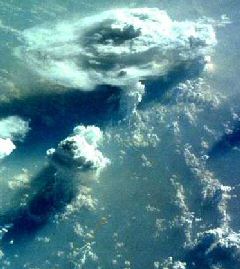7 February 2007
Greenhouse Thermostat Kept Young Earth Balmy
by Kate Melville
 Scientists have for years theorized that high concentrations of greenhouse gases could have helped Earth avoid global freezing in its youth by allowing the atmosphere to retain more heat than it lost. Now, analysis of the world's oldest sedimentary rocks has revealed the first preliminary field evidence supporting this theory. "Our study shows the greenhouse gas that could have sustained surface temperatures above freezing 3.75 billion years ago may have been carbon dioxide," said University of Chicago geologist Nicolas Dauphas.
Scientists have for years theorized that high concentrations of greenhouse gases could have helped Earth avoid global freezing in its youth by allowing the atmosphere to retain more heat than it lost. Now, analysis of the world's oldest sedimentary rocks has revealed the first preliminary field evidence supporting this theory. "Our study shows the greenhouse gas that could have sustained surface temperatures above freezing 3.75 billion years ago may have been carbon dioxide," said University of Chicago geologist Nicolas Dauphas.
Writing in Earth and Planetary Science Letters, the researchers, from the University of Chicago and the University of Colorado, explain how the Earth may have avoided becoming frozen solid early in its history, when astrophysicists believe the sun was 25 percent fainter than today. Previous studies had shown that liquid water existed at the Earth's surface even though the weak sun should have been unable to warm the Earth above freezing conditions. But high concentrations of carbon dioxide or methane could have warmed the planet.
The Quebec rocks at the center of the study were discovered in 2001 and are among the oldest-known in Earth's 4.5-billion-year history. The only other rocks of the same vintage are in western Greenland. The Canadian site is a landscape of rolling hills of grass and marsh, punctuated by lakes, streams and craggy rock outcroppings. Stunted trees of willow grow no more than six feet high, leaving unobstructed views all around. But the region would have looked very different 3.8 billion years ago.
"At that time it would have appeared to be a totally alien world to us, with a dense atmosphere of carbon dioxide and methane that would have imparted a reddish cast to the sky, and deep dark greenish-blue oceans of iron-rich water washing onto beaches of small continents scattered across the globe," said the University of Colorado's Stephen Mojzsis.
The scientists focused their analysis on rocks they suspected contained chemical sediments that precipitate like salt from seawater. "A critical issue with these rocks is that they have been cooked and deformed during burial in the crust for several hundred million years, which makes it difficult to identify their nature," Dauphas explained.
To analyze the rock, the researchers dissolved it and separated the iron oxides and iron carbonates from the other constituents. They then used a mass spectrometer to measure the isotopic composition of the iron. "Iron has several isotopes, and the ratio of these isotopes changes from one to another," Dauphas said. "Sediments that formed by precipitation from seawater have a very distinct signature of iron isotopes." When the Chicago scientists analyzed the iron composition of the rocks; "We found that indeed they had the typical signature of something that formed by precipitation in a marine setting."
The researchers speculate that the iron was probably released with other metals in hydrothermal vents called black smokers found along mid-ocean ridges, where molten lava emerges on the sea floor to create new oceanic crust. In today's oxygen-rich oceans, the iron rapidly precipitates and concentrates near these vents. But in the oxygen-starved oceans of 3.8 billion years ago, oceanic currents could transport the iron long distances before becoming partially oxidized and deposited in sea-floor sediments. Some of these sediments survive today as banded iron formations. "There are no banded iron formations being produced at present because there is too much oxygen," Dauphas said.
Previous research on the ancient rocks from Greenland had already revealed the existence of ocean water in the Precambrian Period. But the Canadian rocks showed something else: the first hints that Precambrian oceans also contained iron carbonates. Iron carbonates can only form in an atmosphere that contains far higher levels of carbon dioxide than are found in Earth's atmosphere today. This carbon dioxide would have played an important role as a planetary thermostat in the support of life on Earth, according to the researchers.
"If it gets cold, ice caps form, chemical weathering decreases, carbon dioxide accumulates in the atmosphere, which increases the greenhouse effect and surface temperatures. If it gets hot, the rate of chemical weathering increases, the rate of burial of sedimentary carbonates increases, the amount of carbon dioxide in the atmosphere and surface temperatures decrease," Dauphas said. "It's possible that such a thermostat was at work as early as 3.75 billion years ago."
Source: University of Chicago
